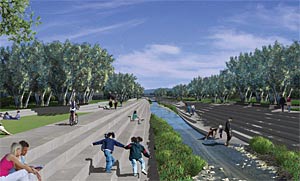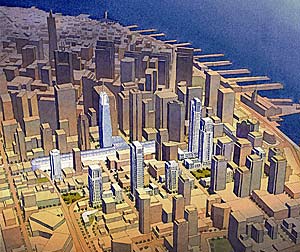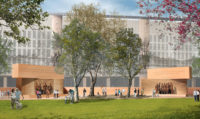Several large urban redevelopment projects are getting underway across California. In Los Angeles, the City Council’s Ad Hoc River Committee is seeking funds from federal, state, and local sources for the Los Angeles River Revitalization Master Plan. The document, which was developed over the past two years by a team including the city’s Bureau of Engineering and Tetra Tech, received council approval in May. It calls for lowering, terracing, and greening much of the waterway’s concrete channel barriers as well as redeveloping surrounding areas into parks: a total of 239 projects along 31 miles of the 51-mile-long river.

Los Angeles is set to begin work on revamping its river.

Image: courtesy Transbay Joint Powers Authority
Architects are vying to design San Francisco’s Transbay redevelopment.

Image: courtesy SOM
SOM leads a team remaking the city’s Treasure Island.
Five “opportunity zones,” which include rail yards downtown and industrial zones in the San Fernando Valley, will receive extra focus to demonstrate how the plan might encourage neighborhood redevelopment. Proposals include constructing new walking paths, a network of tree-lined connector streets, wetlands and wildlife habitat restoration, and new water-treatment facilities. The master plan could take up to 50 years to build out.
Big things are also in the works for San Francisco. Next month, an architect-developer team will be selected to design the Transbay Center: a 1-million-square-foot, multimodal transit hub and adjacent skyscraper on a roughly 12-acre site within a 40-acre downtown redevelopment district. The tower could be the city’s tallest, rising from 850 to 1,200 feet, depending on the city’s final approval.
Transbay’s short-listed architects are Richard Rogers Partnership; Skidmore, Owings & Merrill; and Cesar Pelli & Associates. The team of Santiago Calatrava and Boston Properties decided to withdraw from the competition in mid-May. “Their concern was being able to create an economically viable project for them as a developer,” explains competition manager Donald Stastny, FAIA.
The project is being developed by the Transbay Joint Powers Authority, which is controlled by the City and County of San Francisco, the Alameda-Contra Costa Transit District, and the Peninsula Corridor Joint Powers Board. Once a conceptual design is selected, Stastny says, design development should take two years. Construction is scheduled to begin in 2010, with completion expected by 2014.
An even bigger project is also moving forward in San Francisco: the redevelopment of Treasure Island, a former naval base. The project team includes SOM, which is preparing the master plan, SMWM, CMG Landscape Architects, Baldauf Catton von Eckartsberg Architects, and Hornberger + Worstell, as well as developers Kenwood Investments, Wilson Meany Sullivan, and Lennar.
After receiving preliminary approval from the city’s Board of Supervisors, the developers began preparing an Environmental Impact Report in June. The master plan includes a residential zone containing 6,000 housing units, a 60-story residential tower, a 235,000-square-foot retail center, and a ferry terminal that will provide service to the mainland. There will be 300 acres of open space, including wetlands, playgrounds, and an organic farm. The project’s price tag of $1.2 billion—which excludes building development costs—will be financed through private investment and $700 million in municipal bonds. The first residential units are expected to open in 2013, and the entire project could be finished by 2022.


Post a comment to this article
Report Abusive Comment